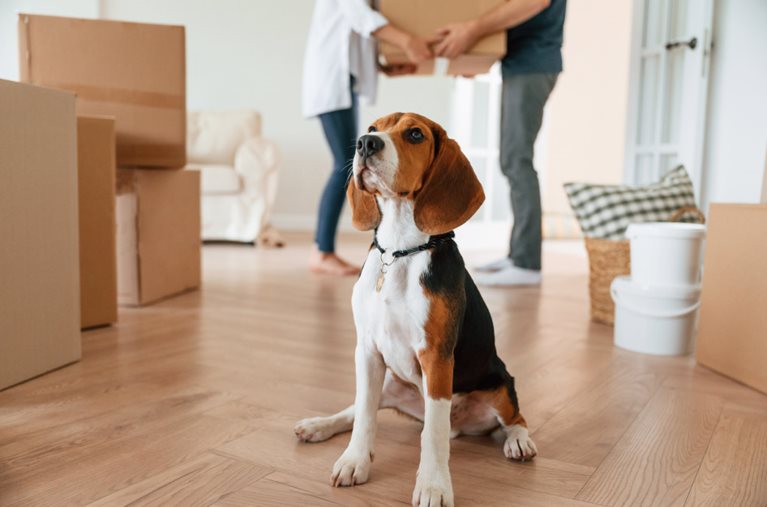
Moving With a Dog? Here are 13 Tips to Keep That Tail Wagging
Moving Tips and Hacks
Are you preparing for a long-distance move? Then you’ve probably got a long to-do list. Are you preparing for that move with a dog? Then that list may need a few more items added to it. But have no fear; a little work on the front end means a better experience down the line. And with that goal in mind, check out these tips for moving with a dog to make the process as stress-free as possible — for everyone involved.
| Heads Up: This advice may be for dog lovers, but we’ve also looked out for our cat people. If you have a Fluffy instead of a Fido or are moving with a dog and a cat, check out this article from the PODS Blog on moving with cats. |
How Do You Handle Moving With a Dog?
First things first: Moving cross-country with a dog (heck, even moving down the street) is easier when he or she feels secure. You both may be going through a stressful and challenging time, but the most beneficial approach is to practice patience and compassion. Recognize that they are facing difficulties, and make an extra effort to simplify the transition for them. If your dog exhibits unusual behaviors, such as having accidents indoors or excessively barking at passersby, understand that these actions stem from stress and anxiety. They are doing their best to cope with the changes. If you follow these tips for moving with a dog, you should observe an overall improvement in his or her mood and behavior.
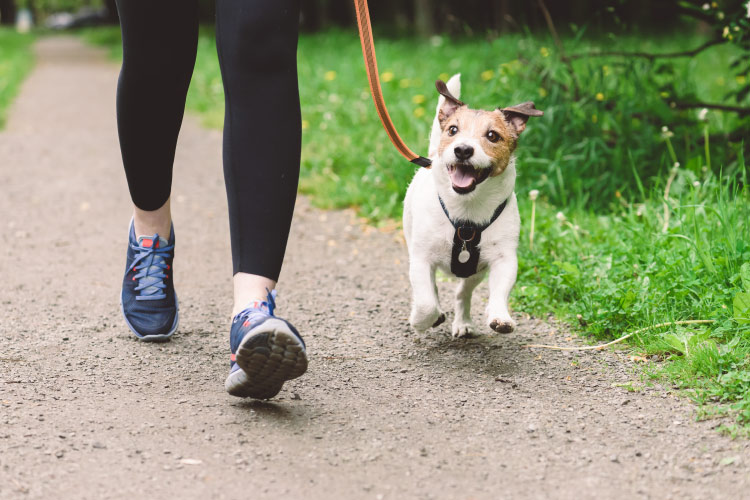
1. Get Your Dog Used to the Change in Routine
It may be slightly traumatic for your dog if you’re in the middle of selling your home, purging your belongings, packing boxes, etc., because your dog is used to your normal daily routine. That’s how he or she knows when it’s time for eating, playing, walking, sleeping, and anything else that you do on a daily basis. But now that you’re fitting more tasks into your day, those anticipated activities and meal times may shift or be forgotten. This disruption can cause canine stress or mood swings.
To keep your dog from experiencing unnecessary anxiety, try to keep their schedule as routine as possible. Have set meal times, and be sure to make time for activity, too. Dogs tend to act out when they have excess energy, so incorporating a few more walks or extra playtime will make them too tired to notice or care that things are different at home.
| Pro Tip: Wondering when it’s best to start the packing process? We recommend beginning around six to eight weeks before your moving day so your pet has enough time to adjust. |
2. Introduce Your Dog to Your Moving Supplies
No, we’re not talking about a formal introduction. Your dog may not like the new sounds and sights that are in your home while you’re packing up your belongings. That packing tape dispenser is louder than you realize! Get them used to the new moving supplies by placing some moving boxes around the house. That way, they can sniff and explore without feeling threatened.
As your dog gets used to the boxes, start packing them gently, so they know the new items are nothing to be worried about. Added points for tossing a few treats their way if they sit by you during the packing process!
3. Stay Calm (or Fake It ’Til You Make It)
This one can be tough during those stressful times when you realize it’s going to take much longer to pack your kitchen than you thought, there are issues with your new home that you can’t handle in person, that work deadline is getting in the way of your much-needed moving prep time, etc., but remember that your body language and tone are being closely monitored by your dog. Talk to them in a calm voice, and remind them that everything will be ok.
It may make you both feel better to talk about the move. Of course, your dog can’t understand the words you’re saying, but they do like being communicated with in a reassuring voice. And it may actually ease some of your stress to share the details with someone who can’t express their opinions.
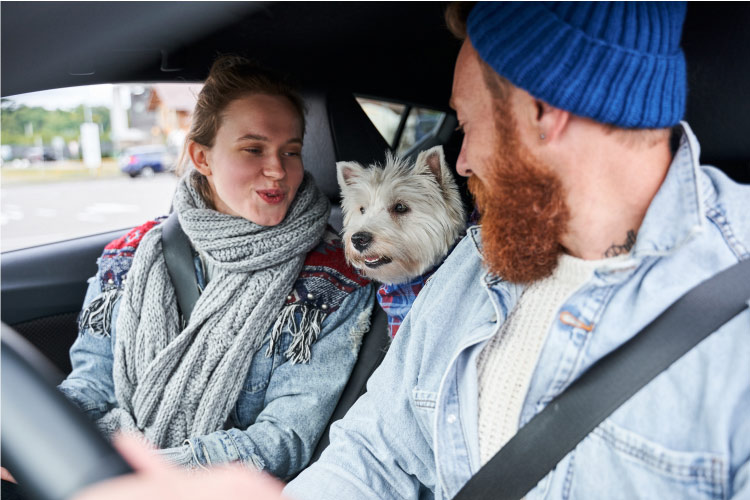
4. Decide on Dog Transportation
If you’re moving with a dog across the country or several hours away from your current location, you may fly or take a train to your destination and have your car professionally transported. Or you may opt for long-distance moving services and make the road trip yourself. Regardless of your choice, it’s wise to plan ahead and decide how you and your four-legged companion will make the trip. Here’s what to expect based on travel type:
Traveling By Car
Unless your dog is prone to motion sickness, this may be the least stressful way to travel with your dog. You can stop for potty breaks, a short walk, meals, etc. And if you want to break the trip into multiple days, you can rest at pet-friendly hotels along the way.
| Pro Tip: Talk to your veterinarian before you move and ask what tweaks you need to make to your dog’s dietary and medication plan. Even if your dog doesn’t suffer from motion sickness, too much food during travel can be tough on their digestive system. Ask if or how much you need to cut back on their daily intake, and inquire about anti-anxiety medication, if you anticipate your dog having trouble remaining calm during the trip. |
Traveling By Plane
Traveling By Train
If you’re taking a train like Amtrak, you can bring your dog along, as long as he or she weighs less than 20 pounds (and, yes, this does include the weight of the pet carrier, which is required). Some pre-travel paperwork is required, so be sure you’ve read the fine print before purchasing your ticket.
| Q: What is the safest way to move with a dog? A: The safest way to transport a dog during a long-distance move is to take them by car in a well-ventilated pet carrier. Be sure they have water and are able to take regular bathroom and meal breaks. And use a well-fitting harness that attaches to your car’s seat belt buckle, if the pet is too large for a crate. It’s dangerous for pets to roam freely in your vehicle. |
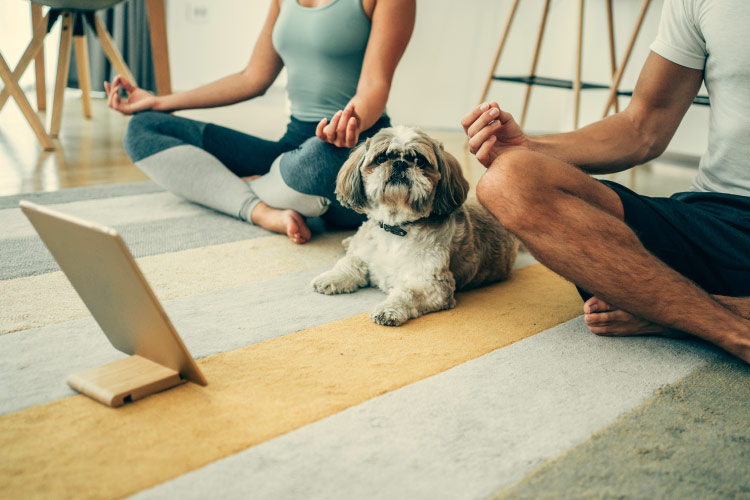
5. Give Yourself Grace
You may be working overtime to keep your dog calm and reassured, but remember that your feelings matter, too. Make time for self-care, and find ways to reduce your own stress during your long-distance move.
Moving can be tough, but moving with dogs is another animal (pardon the pun). Choosing to move with a PODS portable moving container can help reduce the general stress of your move and free you up to give your four-legged friend much-needed attention. Let PODS take care of the driving while you and your pup enjoy a leisurely cross-country trip to your new home.
6. Assign a Moving Day Buddy
You’ll likely be pretty busy on moving day, leaving little time for your dog to receive the usual amount of activity and attention. Make arrangements to have a dog sitter, drop your dog off at a friend’s house, or reserve a spot at a dog daycare, so they’re out of the way but still cared for during this hectic time.
7. Pack Your Dog’s Things Last
Your dog is used to his or her bed, bowl, and other comfort items. Don’t pack these away until it’s absolutely necessary. It’ll help your dog keep his or her routine as normal as possible during this time of transition.
8. Get Your Dog Microchipped
Dogs can be skittish during uncertain times, and while your dog may not be the kind to ever run away, it’s important to be prepared for even the most unlikely of scenarios. Ask your vet to microchip your dog, and ensure they wear identification tags with your phone number during the entire moving process.
9. Double Check Your New Locale’s Pet Rules
Did you know that certain states and cities have rules for pets moving into the area? For example, pets must have a valid health certificate and current rabies vaccination upon arrival in New York and Nebraska. And if you’re moving to Hawaii with a dog, your pet must have two rabies vaccinations and an antibody test within five days of your arrival. If you don’t finish this in time, your dog must quarantine for 120 days.
| Looking for more information? The National Association of Realtors has a list of state regulations pertaining to new pet residents. |
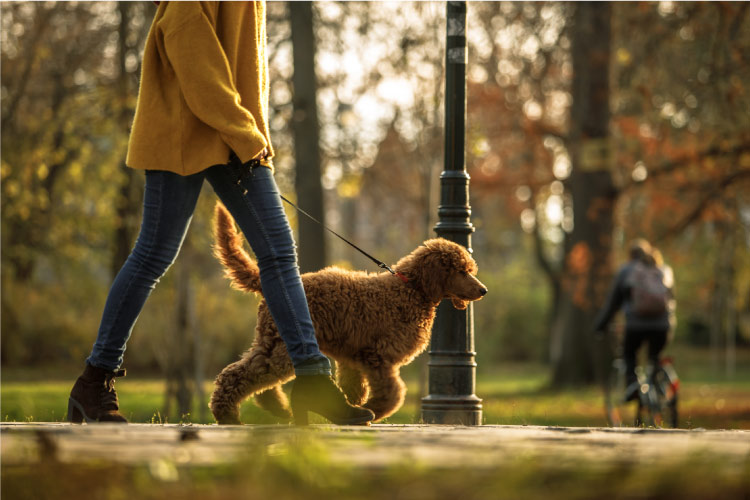
10. Explore Your New Home
You’ve packed, done your homework, handled moving day travel, and you’ve finally arrived at your new home. So what now? Time to introduce your dog to his or her new digs! First, you’ll need to set up your dog’s bed, bowls, toys, etc., and walk your dog to their new safe space. They’ll instantly feel a bit more connected and secure. Next, take them for a walk around the neighborhood. Add some extra time for them to literally sniff things out.
It’s normal if your dog doesn’t feel comfortable and connected to their new space immediately. But how long does it take for a dog to get used to a move? That’s a tough one to answer, as every dog is different. Some will adjust in a few days, while others may take weeks.
11. Reward Good Behavior
If your dog is having trouble settling into his or her new home, try some positive reinforcement. Give your dog a treat or toy when they settle into their bed, and, as we said before, make sure there’s plenty of time for exercise during the day. One of the best ways to alleviate canine anxiety is through activity.
12. Don’t Change Too Much Too Soon
The thrill of redecorating and revamping your new home is one of the best parts about moving to a new home — especially if you're overly excited about getting rid of that worn-out futon from college or your mom’s hand-me-down kitchen table. However, exercise caution and resist the urge to discard all your furniture at once. You may not realize it, but your dog knows your things and furniture and may not share your enthusiasm for a complete overhaul. Allow a few weeks to pass before you start making major changes. And if possible, arrange your furniture in a configuration reminiscent of your previous home. Both your dog and your wallet will appreciate your thoughtful approach.
13. Enjoy the Moments
As you embark on this new chapter of life with your furry companion, remember that moving with a dog can be an adventure filled with joy and bonding. Take the time to create a comfortable and familiar environment for your four-legged friend in your new home, and prioritize their well-being throughout the moving process.
Whether it's exploring new parks together, establishing routines, or simply showering them with love, your dog will be your steadfast companion, making every step of the journey worthwhile. Cherish the moments of discovery and growth as you both settle into your new surroundings, creating a home where wagging tails and happy barks echo the warmth of a loving and well-adjusted family.
LB Gabriel is a freelance writer who lives with her husband, daughter, and Golden Retriever in Memphis, TN. A frequent PODS Blog contributor, she’s a sucker for any tip she can find on downsizing, cutting clutter, or minimalist living. When she’s not on a deadline, you can find her on a tennis court or golf course.
Related Articles
Comments
Leave a Comment
Your email address will not be published. Required fields are marked *
